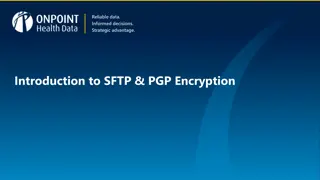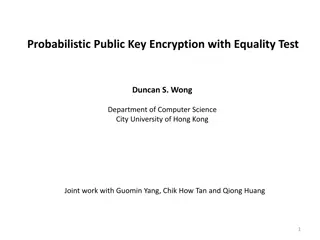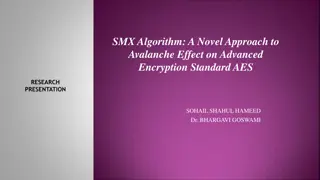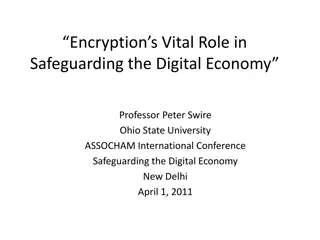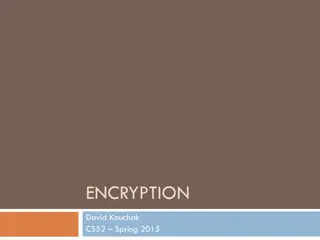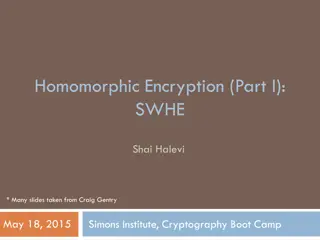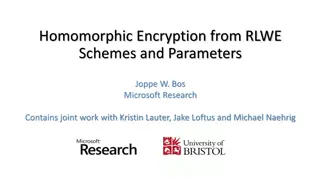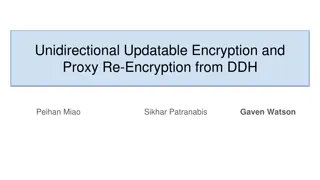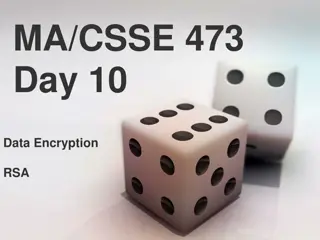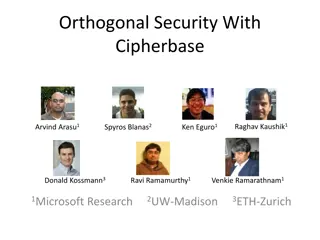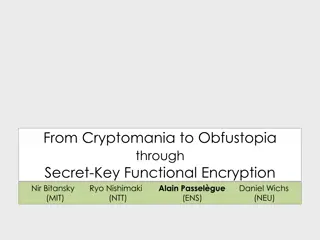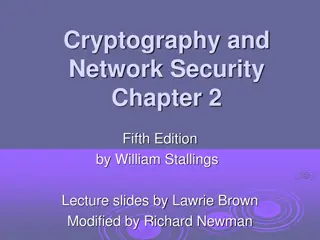Introduction to Wireless Network Encryption
Basic encryption techniques for wireless networks are essential for maintaining data security. IEEE 802.11-1997 established standards requiring a minimum 40-bit key, typically set at 104 bits, utilizing RC-4 encryption. Despite advancements, older networks still widely use this encryption. Encryption keys, initialization vectors, and packet key generation play crucial roles in securing wireless data transmission. Understanding the nuances of WEP security is vital for network administrators and cybersecurity specialists.
Download Presentation

Please find below an Image/Link to download the presentation.
The content on the website is provided AS IS for your information and personal use only. It may not be sold, licensed, or shared on other websites without obtaining consent from the author.If you encounter any issues during the download, it is possible that the publisher has removed the file from their server.
You are allowed to download the files provided on this website for personal or commercial use, subject to the condition that they are used lawfully. All files are the property of their respective owners.
The content on the website is provided AS IS for your information and personal use only. It may not be sold, licensed, or shared on other websites without obtaining consent from the author.
E N D
Presentation Transcript
MIS 5211.701 Week 13
WEP Revisit Kismet Introduction to Aircrack Attacking WEP WPA-PSK Shellter Cain and Abel / John the Ripper MIS 5211.701 2
Basic encryption for wireless networks Specified in IEEE 802.11-1997 Required a minimum 40-bit key, usually set at 104-bit Uses RC-4 encryption Applied only to data frames (Payload) Still widely used, especially on older gear MIS 5211.701 3
Described as 64 or 128 bit Reality is 40 or 104 The pre-shared key (Not the same as WPA- PSK) is either 5 or 13 bytes Initialization vector is transmitted with each packet IV and key are concatenated to create a per packet key IV is not a secret! Four possible keys, index 0-3 MIS 5211.701 4
One bit field in the frame control field Called by a number of different names WEP bit Privacy bit Secure bit With this bit set, the receiving station expects to see a four byte WEP header immediately following the 802.11 header Also expects to see a four byte trailer immediately following the payload or data portion MIS 5211.701 5
The four byte header is also the initialization vector or IV along with the index number to designate which WEP key was used Again, this was used with the WEP key to encrypt the data packet The four byte trailer is the Integrity Check Value or ICV This function similar to a CRC check to protect against packet modification MIS 5211.701 6
Stream cypher One byte at a time 100 bytes of plaintext = 100 bytes of cypher text + eight bytes of WEP overhead Requires a unique key (No re-use) Recall: concatenated from IV and shared secret Uses a pseudo randomization function referred to as PRGA (Pseudo-random generation algorithm ) PRGA is XOR d with the plaintext MIS 5211.701 7
Poor Key selection Message integrity check Initialization Vector (too short) No replay protection Challenge response reveals PRGA Key is reversible from cypher test (XOR) MIS 5211.701 8
Restricted to 5 or 13 character pre-shared key Reduced key efficiency to 224 Users often use dictionary words MIS 5211.701 9
Weak IV selection leads to key recovery Known plaintext reveals key information First two bytes of WEP payload are mandated by 802.11 header spec (0xAA 0xAA) Once you have enough weak IVs, you can recover the key We will look at the Aircrack-ng tool for this MIS 5211.701 10
Pre-installed in Kali Similar issue to Kismet, will need to launch from terminal, not from drop down Aircrack-ng site has detailed information on installation, building from source, and use http://aircrack-ng.org/ MIS 5211.701 11
Need to connect wireless card to Kali Need to verify using iwconfig command Then launch Kismet for a little recon This will also force the wireless card in to monitor mode Since StarDrive is my AP we ll focus on it MIS 5211.701 12
Double clicking on name gives me detail screen Note MAC Address WEP bit Network menu has option to close window and return to summary MIS 5211.701 13
We found the AP we want to attack Know Name (SSID), MAC Address (BSSID), WEP This also had the affect of forcing wlan0 into monitor mode MIS 5211.701 14
Lots of extras at: http://aircrack-ng.org/doku.php?id=tutorial We ll run through a few MIS 5211.701 15
Created ARP traffic to get data faster You do need access to wired network, so limited applicability in the wild Use command: MIS 5211.701 16
Running command: This will create log file capture*.cap for further analysis MIS 5211.701 17
Once enough data has been collected, run aircrack-ng output*.cap If you don t have enough data you will see MIS 5211.701 18
Eventually, with enough IVs you can get to this: MIS 5211.701 19
Recall, WPA introduced TKIP WPA2 introduced CCMP and kept TKIP Both work with both personal and enterprise Personal PSK, Enterprise 802.1x WPA and WPA2 very similar for PSK MIS 5211.701 20
PSK Pre-Shared Key KEK Key Encryption Key PMK Pairwise Master Key Comes from PSK or EAP method PTK Pairwise Temporal Key Two MIC keys (RX and TX EAPOL Key Encryption Key EAPOL Key Confirmation Key MIS 5211.701 21
PMK is 256 bits in length PMK is derived using passphrase, ssid, and ssid length information Hashed 4096 times using HMAC-SHA1 This means process cannot be reversed to extract passphrase MIS 5211.701 22
Combines MAC of STA and AP with STA and AP nonces Update nonces generate fresh keys Uses PMK as additional input (Re: Key) along with the phrase Pairwise Key Expansion and combines with above and hashed w/ SHA1 to generate a PTK Note: Nonce is a random value generated by both STA and AP MIS 5211.701 23
PTK is 384/512 bits in length First 16 bytes HMAC MIC key Next 16 EAPOL-Key KEK Next 16 Temporal Encryption Key Next 8 TX TKIP Michael (MIC) Key Next 8 RX TKIP Michael (MIC) Key MIS 5211.701 24
Step 1 ANonce, start new PTK negotion SNonce, MIC of Frame 2 MIC of frame 3 MIC of frame 4, ready to TX/RX Step 2 Step 3 Step 4 MIS 5211.701 25
Example First four lines are 4-Way Handshake Source has capture file if you want to look for yourself Source: http://mrncciew.com/2014/08/16/decrypt-wpa2-psk-using-wireshark/ MIS 5211.701 26
AP beacon frames identify capability information Cypher suite support Auth key management Wireshark can filter traffic, then manual inspection can identify MIS 5211.701 27
Example of beacon frame in wireshark MIS 5211.701 28
The PMK is generated using the following relatively processor intensive function, pseudo code: PMK = PBKDF2(passphrase, ssid, ssidLength, 4096, 256) This means that the concatenated string of the passphrase, SSID, and the SSID length is hashed 4096 times to generate a value of 256 bits MIS 5211.701 29
PTK = PRF-512(PMK, "Pairwise key expansion", Min(AP_Mac, Client_Mac) || Max(AP_Mac, Client_Mac) || Min(ANonce, SNonce) || Max(ANonce, SNonce)) The PTK is a keyed-HMAC function using the PMK on the two MAC addresses and the two nonces from the first two packets of the 4-Way Handshake. MIS 5211.701 30
Finally, recall: MIC = HMAC_MD5(MIC Key, 16, 802.1x data) A MIC value is calculated, using the MIC Key from the PTK and the EAPoL message. MIS 5211.701 31
So, we captured the Mac Addresses and the ANonce and SNonce from the four way handshake Source: http://mrncciew.com/2014/08/16/decrypt-wpa2-psk-using-wireshark/ MIS 5211.701 32
Now, if we had the right passphrase, SSID, and SSID length; we have everything we need to generate our own key. But we don t have this information! At least not directly MIS 5211.701 33
Collect data from four handshake Mac Addresses ANonce and SNonce MIC and EAP Read in value from a dictionary list Calculate PMK using dictionary word and SSID Calculate PTK using above information Calculate MIC of frame using PTK Compare calculated MIC to observed MIC If equal, done! If not equal read in next dictionary word and start over MIS 5211.701 34
Several tools exist to automate this process Cowpatty Pre-installed in Kali http://www.willhackforsushi.com/?page_id=50 Aircrack-ng Pre-installed in Kali http://aircrack-ng.org/downloads.html MIS 5211.701 35
Slow (Very slow) Each time you want to check a passphrase you have to go through the 4,096 hashes Each time you go after another SSID, you start over again Calculations are limited by the capabilities of the CPU installed MIS 5211.701 36
Pre-Computed Hash Tables (Rainbow) PMK is derived from the PSK and SSID Possible to precompute PMK s for a given SSID Top 1000 most common SSIDs published https://wigle.net/ Or http://www.renderlab.net/projects/WPA-tables/ Cowpatty will accept precomputed hash tables See genpmk in a couple of pages MIS 5211.701 37
MIS 5211.701 38
MIS 5211.701 39
Basic tool to precompute hashes Can speed up attacks by a factor of 1300 genpmk written by Josh Wright Pre-installed in Kali Packaged with Cowpatty MIS 5211.701 40
CUDA Acceleration Parallel computing architecture developed by nVIDIA http://www.nvidia.com/object/cuda_home_new.html Pyrite CUDA acceleration of Cowpatty PMK tables Included in Kali Pyrite also supports AMD/ATI 43XX cards (they typically cost less) Could also go to the cloud MIS 5211.701 41
Method Algorhithm IV Size Key Length Key Manageme nt None 4-way Integrity Check WEP WPA RC4 RC4, TKIP 24 48 40/104 128 CRC-32 Michael Algorithm and CRC- 32 CBC-MAC BIP- GMAC-256 WPA2 WPA3 AES-CCMP AES-GCMP 256 48 Arbitrary 1-2^64 128 192 4-way ECDH and ECDSA MIS 5211.701 42
A different tool for creating malicious executables Encrypts malicious code to bypass Anti- Virus https://www.shellterproject.com/download/ MIS 5211.701 44
? MIS 5211.701 46



